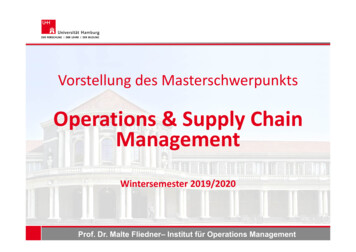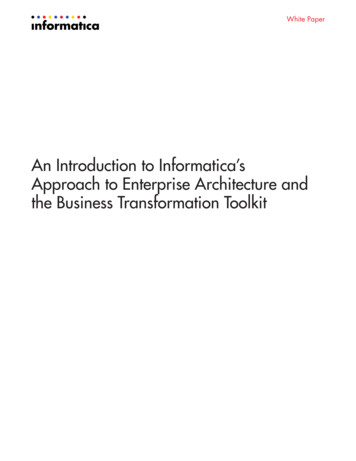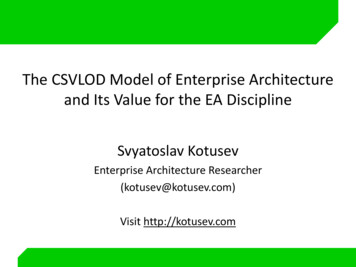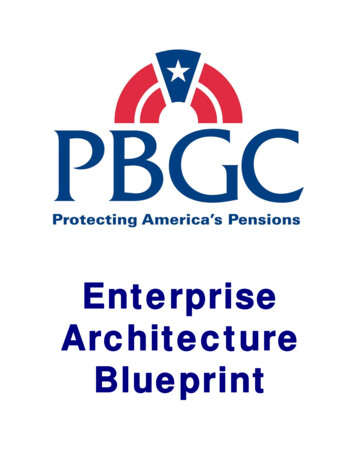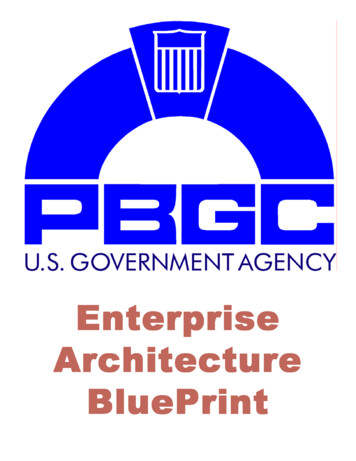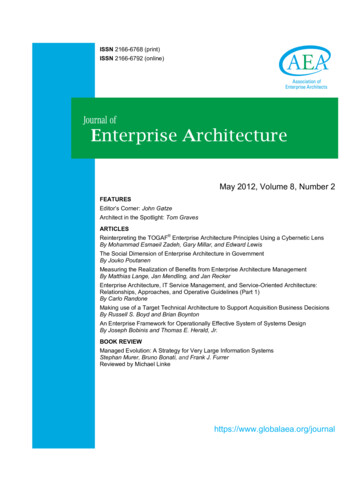
Transcription
ISSN 2166-6768 (print)ISSN 2166-6792 (online)Journal ofEnterprise ArchitectureMay 2012, Volume 8, Number 2FEATURESEditor’s Corner: John GøtzeArchitect in the Spotlight: Tom GravesARTICLESReinterpreting the TOGAF Enterprise Architecture Principles Using a Cybernetic LensBy Mohammad Esmaeil Zadeh, Gary Millar, and Edward LewisThe Social Dimension of Enterprise Architecture in GovernmentBy Jouko PoutanenMeasuring the Realization of Benefits from Enterprise Architecture ManagementBy Matthias Lange, Jan Mendling, and Jan ReckerEnterprise Architecture, IT Service Management, and Service-Oriented Architecture:Relationships, Approaches, and Operative Guidelines (Part 1)By Carlo RandoneMaking use of a Target Technical Architecture to Support Acquisition Business DecisionsBy Russell S. Boyd and Brian BoyntonAn Enterprise Framework for Operationally Effective System of Systems DesignBy Joseph Bobinis and Thomas E. Herald, Jr.BOOK REVIEWManaged Evolution: A Strategy for Very Large Information SystemsStephan Murer, Bruno Bonati, and Frank J. FurrerReviewed by Michael Linkehttps://www.globalaea.org/journal
Journal of Enterprise ArchitectureChief Editor: John Gøtze, PhD, IT University of CopenhagenAssociate EditorsAndy BlumenthalJames Lapalme, PhDDivision Chief, US Department of StateEnterprise Architecture Consultant and ResearcherTyson Brooks, PMPHaiping Luo, PhDSchool of Information Studies, Syracuse UniversityInternational Trade Administration, US Dept. of CommerceDick BurkStephen Marley, PhDEnterprise ArchitectHarris CorporationBrian Cameron PhDThomas J. Mowbray, PhDProfessor & Executive Director, Center for EA, PA State UniversityTASC, Inc.Larry DeBoeverGeorge ParasassureEVManaging Director, EADirectionsGary DoucetPallab Saha, PhDHuman Resources and Skills Development CanadaProfessor of Information Systems, National University of SingaporeRobert Ellinger, PhDCathy SowellEnterprise ArchitectPresident, Custom Enterprise Solutions, LLCLen FehskensTorben TamboVP, Skills and Capabilities, The Open GroupAssociate Professor, Aarhus University Institute of Business & TechnologyKristian Hjort-Madsen, PhDMichael TiemannManager, AccentureProgram Director, FEAC InstituteJups Heikkilä, PhDPat TurnerProfessor, University of TurkuDirector, Centre for EA & Research Management, Griffith UniversityMichelle Kaarst-Brown, PhDTim WestbrockAssociate Professor, Information Studies, Syracuse UniversityManaging Director, EADirectionsLeon Kappelman, PhDJohn A. ZachmanCollege of Business, University of North TexasZachman InternationalWilliam W. Krauter, PhDSenior Architect, Lockheed Martin CorporationAbout the Journal: The Journal of Enterprise Architecture (JEA) is published quarterly by the Association of Enterprise Architects, 44Montgomery Street, Suite 960, San Francisco, CA 94104, Tel: 1 415 374-8280, Fax: 1 415 374-8293, www.globalaea.org/journal.The Journal is a peer-reviewed international quarterly publication for the Enterprise Architecture community. Issues are published inFebruary, April, August, and November each year. JEA supports global academic and practitioner communities of interest through thepublication of articles that promote the profession of Enterprise Architecture, and deals with issues regarding practices and methods,case studies, and standards at the national and international levels. Note that the views expressed in JEA articles are those of therespective authors, and not necessarily those of the publisher, the editorial board, or the Association of Enterprise Architects (AEA).Sponsors: JEA is sponsored by AEA (publisher), the Institute for Software Research International at Carnegie Mellon University, andthe School of Information Studies at Syracuse University.Copyright: 2005-2012 Association of Enterprise Architects. The reproduction, storage, or transmission of JEA articles or othercontent is prohibited without prior permission in writing from the JEA Chief Editor, who can be contacted via email atjohn@gotzespace.dk.Article Submissions: Authors may submit properly formatted manuscripts to the JEA Chief Editor atjournal.submissions@globalaea.org for peer-review and publication consideration. Author submission guidelines are available on theJournal website at https://www.globalaea.org/journal. Approximate timeframes from submission to publication for successfulmanuscripts are 6 to 12 months, depending on the backlog of previously accepted manuscripts. Copyright of all accepted articles andother published content is transferred by the author to JEA upon notification of acceptance by the JEA Chief Editor.Subscription: Print edition: US 20.00 per issue, US 70.00 per year. Online edition: no charge access for AEA membership. Theannual cost of AEA associate membership is US 70.00. To join, please refer to ck Issues: All back issues are available in electronic form, and can be accessed online by subscribers. Libraries can apply foraccess by contacting AEA.2 Journal of Enterprise Architecture – May 2012
ContentsEditor’s Corner . 4Architect in the Spotlight . 5Reinterpreting the TOGAF Enterprise Architecture Principles Using a Cybernetic Lens . 9The Social Dimension of Enterprise Architecture in Government. 19Measuring the Realization of Benefits from Enterprise Architecture Management . 30Enterprise Architecture, IT Service Management, and Service-Oriented Architecture: Relationships, Approaches, andOperative Guidelines (Part 1). 45Making use of a Target Technical Architecture to Support Acquisition Business Decisions . 56An Enterprise Framework for Operationally Effective System of Systems Design. 60Book Review . 76 Journal of Enterprise Architecture – May 20123
Editor’s CornerBy John GøtzeThe Journal of Enterprise Architecture is called a“pracademic” journal because it welcomes bothpractitioners and academics. This number is a goodexample, with contributions from both practitioners andacademics.CALL FOR CASES AND PRACTITIONERS’ ADVICETHIS NUMBERAs something new, JEA can now offer ten (10) AEACPD (Continuing Professional Development) credits foraccepted submissions (full papers, cases, practitioners’advice).The Architect in the Spotlight is Tom Graves, consultantand author of several Enterprise Architecture books.Mohammad Esmaeil Zadeh, Gary Millar, and EdwardLewis offer a reinterpretation of the TOGAF EnterpriseArchitecture Principles using a cybernetic lens.Jouko Poutanen discusses the social dimension ofEnterprise Architecture in government.Matthias Lange, Jan Mendling, and Jan Recker discussways of measuring the realization of benefits fromEnterprise Architecture Management.Carlo Randone will, in a two-part article, offer a thoroughcomparison of Enterprise Architecture, IT ServiceManagement, and Service-Oriented Architecture.Russell S. Boyd and Brian Boynton offer some thoughtsabout how to make use of a target technical architectureto support acquisition business decisions.Joseph Bobinis and Thomas Herald present anenterprise framework for operationally effective systemof systems design.Michael Linke reviews the book “Managed Evolution: AStrategy for Very Large Information Systems”.4Please consider sharing your story with the EnterpriseArchitecture community. Whether a case study or justsharing some experience, do submit a paper for JEA.Read more on https://www.globalaea.org/journal.SERIOUS SERIALI am pleased to announce that JEA finally holds anISSN. Two, in fact: ISSN 2166-6792 (Online) and ISSN2166-6768 (Print), awarded by the US Library ofCongress. JEA also now has an OCLC Number(781629072) and bibliographic information in the globallibrary database Worldcat.JEA ARCHIVESWe have extended our digital archives, and have allpublished numbers available for (members) download athttps://www.globalaea.org/journal.ABOUT THE EDITORDr. John Gøtze is program manager at the IT Universityof Copenhagen and lecturer at Copenhagen BusinessSchool. He is also a partner in EA Fellows, and runsCarnegie Mellon University’s EA Certification program inEurope. He can be reached on john@gotzespace.dk. Journal of Enterprise Architecture – May 2012
Architect in the SpotlightTom GravesPLEASE INTRODUCE YOURSELFWHAT IS THE GREATEST CHALLENGE FACINGENTERPRISE ARCHITECTURE TODAY?You might say I’m that somewhat-scruffy, slightly wildeyed sixty-ish guy over there in the far corner of EA, withall those crazy ideas that actually do work. Originallyfrom England, I’ve kind of “careered” all over the place –Britain, USA, Australasia, various places in Europe, andnow increasingly in Latin America. I started out as agraphic designer, writer, and skills educator, gotsidetracked into becoming one of the pioneers ofdesktop-publishing (yep, plenty of all-night debugsessions – all in assembly-language back in those days),and then kept on moving sideways from there. Media,publishing, engineering, finance, logistics, ncyservices, recruitment, health, medicine, research,banking, just to name a few – I’d guess I collectindustries like other people collect postage stamps. It’sbeen quite a ride.It’s the same as it has been for the past decade andmore: establish its identity and role. (Len Fehskens atOpen Group is one person who’s doing great work onthis challenge: see his article Enterprise Architecture’sQuest For Its Identity1). EA is still a blurry, ill-defineddiscipline without a clear sense of purpose: the ongoingconfusion about what it is and isn’t is not helpinganyone. EA is also still all but crippled by IT-centrism,and it’s long past the time we should have escaped thatparticular trap: again, Len Fehskens is great on this. Thenext danger is business-centrism, the notion that “thebusiness of the business” is the center of everything, atrap that several groups are falling into already: we needto make it clear that in a real architecture of theenterprise, everywhere and nowhere is “the center”, allat the same time.HOW DID YOU BECOME INVOLVED WITHENTERPRISE ARCHITECTURE?WHAT IS THE NEXT BIG THING IN ENTERPRISEARCHITECTURE?As seems usual for me, it was more from serendipity andhappenstance than by deliberate intent. I’ve never yetbeen a formal employee – always an independent or oneof a team of consultants – so I’ve always had to be ableto turn my hand to anything. Perhaps most importantwas that there was no one point at which I would havesaid “Now I’m going to do EA”, more that just abouteverything I did over a couple of decades or moreincluded some or other key components of EA: ITintegration, information architecture, whole-of-processdesign, inter-project rationalization, business models,skills mapping, quality management, knowledgemanagement, and so on. One key transition was at abusiness-transformation gig at Australia Post: our workhad to cover the intersection of everything – human,machine, and IT – whereas the so-called “EnterpriseArchitecture” team would only look at anything thattouched IT, with no awareness or interest in how thataffected the business anywhere beyond that narrowscope. It didn’t make sense, and still doesn’t, which iswhy I’ve spent most of the last decade trying to educateour industry that EA literally means “the architecture ofthe enterprise” – not merely the small subset of theenterprise that is its IT.Not so much a single “big thing” as the confluence of aswathe of inter-related themes: On the IT side, themes such as the impact of bigdata, mobility, and BYOD (Bring Your Own Device),and the implications of ubiquitous sensors and “theInternet of Things” On the business side, the shift in focus fromproducts to services, and from business plans tobusiness models and business ecosystems Beyond individual organizations, there’s theincreasing fragmentation and globalization of work,the still-accelerating pace of change, and theincreasing complexities of multi-company consortiafor every form of business Deeper still, the increasing discontent with thefundamentals of “business as usual”, andincreasing rejection of the externalities andexternalization on which many business models stilldepend1Refer to: hitecture%E2%80%99s-quest-for-its-identity/. Journal of Enterprise Architecture – May 20125
For EA itself, the implications of breaking out of theIT-centric box, expanding outward to a true wholeof-enterprise scopeThere are huge risks there, but also huge opportunitiestoo, for our organizations, and for us as EnterpriseArchitects. Yet do we have the skillsets andcompetencies to cope with the huge scope of a trueglobalized “architecture of the enterprise”? That’s ourchallenge here.WHAT IS IT LIKE BEING ENTERPRISE ARCHITECT?An intensity of emotions: challenging, exciting,frustrating, exhilarating, often all at the same time;always changing, always right at the edge of change,always at risk of falling into the abyss. In short, a scaryplace. But rarely dull!WHAT WAS YOUR FAVORITE ENTERPRISEARCHITECTURE EXPERIENCE?For me it’s always been the same, for the past fourdecades and more: seeing the body language whensomeone “gets it”. That and hearing someone say: “Oh, Ihadn’t thought of it that way before ”. In a EA context,often what they “get” is that things really do work betterwhen they work together, that it’s up to them to make ithappen, and that they can make it happen. But the“getting it” can be about anything, really. That’s whatreally keeps me going in this work: seeing people “get it”.WHAT WAS A LEAST FAVORITE ENTERPRISEARCHITECTURE EXPERIENCE?The opposite: being stuck with people who really don’t“get it”, are unlikely ever to “get it”, may even believe thattheir job or bonus depends on not “getting it”. A realexample: our (very good) lead business contact hadbeen promoted elsewhere, so I’m talking with herreplacement, to bring her up-to-speed on what we’redoing. I explain that because their business is in ahuman services context, their EA needs to cover a muchbroader scope than just IT processes and data. “Yes”,she says, “Enterprise Architecture is all about ITprocesses and data”. I blink, then try again: “We need tocover a broader scope than just IT”, I say. ”Yes, I agreewith you”, she says, ”we’re only going to cover ITprocesses and data”. Barely six weeks into the contract,it’s clear that, with this person in charge, this EA projectis already dead in the water. Oh well. Yet, even whencrippled by that kind of problem, some projects do workwell – and they’re the projects that make it allworthwhile.6WHAT WOULD YOU SAY TO SOMEONECONSIDERING MAKING EA THEIR CAREER AREA?(AND TO SOMEONE HAVING AN EA CAREER?)A few hard-won experiences: Be in it for the long haul: it really does takedecades to gather the breadth of experience you’llneed to do this job well. I know a few folks doingvery good work in their twenties or thirties, but mostEnterprise Architects don’t really hit their stride untiltheir forties or more. Be humble: as a generalist, almost everyonearound you knows their job far better than you’llever do. Your job is to listen and link thingstogether, not to tell others what to do. Be interested in everything and everyone: there’salways more to learn. Often the most valuablecontacts are the janitors: they see everything that’sgoing on! Keep contact with the real-world: don’t hide away inthe abstract. Design may no longer be your job assuch – that’s for solution-architects, not you – butyou’ll always need to refresh your real-worldexperience to ensure that your architecture canactually be used and useful. Develop your soft-skills: they’re even moreimportant than your technical-skills – yet often a lotharder, too. Most of the real work of EnterpriseArchitecture is in creating conversations, buildingbridges between people with different views andmindsets: you’ll need very good soft-skills to makethat work well.Most of all, though, this is a great field to work in: so gofor it!This section aims to bring recognition to a variety ofcontributors to the Enterprise Architecture (EA) field –from early pioneers, to current practitioners beginningtheir careers, to experts from other fields that influenceEA – and is intended to show the rich diversity ofbackgrounds and views that the EA community enjoys. Journal of Enterprise Architecture – May 2012
Visit the JEA website at https://www.globalaea.org/journalCall for PapersThe Journal of Enterprise Architecture is accepting article submissions for its future issues. Research and best practicearticles are sought on Enterprise Architecture-related topics, including: Case Studies, Configuration Management, Culture, Documentation Evaluation, Frameworks, Governance, Implementation, Maintenance Methodologies, Taxonomies, Theory, Training, Tools, Use, ValueThe annual cycle includes four numbers. Deadlines for final submissions are three months prior to publication:IssueDue DateFebruaryNovember 1MayFebruary 1AugustMay 1NovemberAugust 1Please send articles to the JEA Editor at journal.submissions@globalaea.org.Author submission guidelines can be found on the JEA website at https://www.globalaea.org/journal. Journal of Enterprise Architecture – May 20127
AC M/I E E E 15t h I n t er n atio nal C o n f er enceon Model Driven EngineeringLanguages & SystemsSept 30 – Oct 05 2012, Innsbruck, AUSTRIAhttp://modelsconference.orgJury (to be confirmed):Thomas Allweyer(University of Applied SciencesKaiserslautern, Germany)Colin Atkinson(University of Mannheim,Germany)Ruth Breu(University of Innsbruck, Austria)Bernd Brügge, Ph.D.(Technische UniversitätMünchen, Germany)Bernd Dreier(University of Applied SciencesKempten, Germany)Model Gamification Challenge @ MODELS 2012 – Call for SubmissionScopeModels are used in many different software engineering and management disciplines as tools to communicateinformation, to express and analyze system properties at an abstract level, to plan future changes, and toanalyze complex interdependencies. In order to use models effectively system stakeholders have to understandthe rules and languages used to create them and to become familiar with the way models convey information.Gamification is an increasingly popular strategy for helping stakeholders in a system gain an intuitiveunderstanding of the way that it works and the goals that it is intended to fulfill. It involves the translation of asystem, or parts of a system, into a game whose rules of play are designed to teach and communicate centralaspects of the system’s behavior and functionality. Model Gamification applies this notion to the use of modelsin IT systems modeling – it aims to use game playing techniques to teach users how to create, interpret andwork with models. As an example, http://www.eagame.net/ and [1] demonstrate the idea of modelgamification in the area of Enterprise Architecture Modeling.Other domains where gamification may be beneficial include: John Gøtze(IT‐University of Copenhagen,Denmark)Giancarlo Guizzardi(Federal University of EspiritoSanto, Brazil)Stijn Hoppenbrouwers(Radboud University Nijmegen,Netherlands)Dimitris Karagiannis(University of Vienna, Austria)Florian Matthes(Technische UniversitätMünchen, Germany)Erik Proper(Public Research Centre – HenriTudor, Luxembourg)Christian M. Schweda(iteratec GmbH, Germany)Elena Simperl(Karlsruhe Institute ofTechnology, Germany)Marten van Sinderen(University of Twente,Netherlands)Imp o rt an t Dat es:July 26, 2012 Submission DeadlineSept 03, 2012 Notification ofAcceptanceSoftware Architecture ModelingBusiness Process ModelingRequirements ModelingModel‐Based TestingSubmission and Evaluation ProcedureThe goal of the MODELS 2012 Gamification Challenge is to promote the use of gamification techniques inmodel‐driven development by identifying innovative and effective modeling gamification strategies. Thechallenge solicits descriptions of innovative gamification strategies in the form of concept papers conforming tothe ACM format (up to 4 pages). These should explain the rules of game play and describe how the game helpsusers learn how to communicate/gather/analyze information based on models. The submissions will beevaluated through a two‐phase process.1.In round one, the papers will be evaluated by the program committee and the three best submissionswill be selected.2.In round two, each of these three papers will be presented in a short slot during the main conferenceand the winning submission will be selected by the audience. This paper will be published in theelectronic MODELS 2012 workshop proceedings.In round one, submissions will be assessed according to their innovativeness and appropriateness forcommunicating/gathering/analyzing information based on models as well as their suitability for the context ofsoftware engineering and IT management. In the second round, submitters are encouraged to implement aprototype realizing the game, although this is not mandatory. We particularly encourage student teams tosubmit concepts.Each of the three invited author teams will receive one free registration for the main conference. The winningteam will receive a prize of 500 awarded by the German Chapter of the ACM. Additional funding for travelsupport is available upon request.[1] J. Groenewegen, S.J.B.A. Hoppenbrouwers, and H.A. Proper. Playing ArchiMate Models. In I. Bider et al. (eds): Enterprise,Business‐Process and Information Systems Modeling ‐ 11th International Workshop, BPMDS 2010 and 15th International Conference,EMMSAD 2010, held at CAiSE 2010, Tunis, Tunesia, June 2010, volume 50 of Lecture Notes in Business Information Processing, pages182‐194. Springer, Berlin, Germany, 2010.Oct 04, 2012 Date of PresentationAll deadlines are hard. No extensionswill be allowed. (All dates areaccording to time zone UTC).8 Journal of Enterprise Architecture – May 2012
ArticleReinterpreting the TOGAF Enterprise Architecture PrinciplesUsing a Cybernetic LensBy Mohammad Esmaeil Zadeh, Gary Millar, and Edward LewisAbstractIn the literature, there are many definitions of Enterprise Architecture (EA), but most of them have three items in common:elements, relationships, and principles. Among these, principles represent an essential element in the definition of EA,and some researchers posit that they are the main element in this definition. However, despite the recent advances indefining Enterprise Architecture Principles (EAPs), this notion is suffering from the lack of a theoretical foundation thatprovides a logical framework for defining them. Stafford Beer’s Viable System Model (VSM) and its application to ITgovernance, the Viable Governance Model (VGM), have been shown to be comprehensive blueprints for designing viableorganizations and IT governance arrangements, respectively. Similarly, in recent realizations of EA, the design of thewhole organization, and not just the IT, is brought into consideration. Therefore, this article aims to establish whether thelaws and principles of cybernetics, especially those embodied in the VSM and the VGM, can provide a sound theoreticalbasis for deriving EAPs. This article investigates the principles defined in TOGAF based on the theoretical conceptsdrawn from the VSM/VGM and cybernetics more broadly. This investigation demonstrates that the principles in TOGAF can be derived from the laws and principles of cybernetics.KeywordsEnterprise Architecture (EA), Principles, Viable System Model (VSM), CyberneticsINTRODUCTIONIn the literature, there are many definitions for EnterpriseArchitecture (EA) (Lewis 2012), showing different viewsabout this discipline and different roles it plays indesigning organizations. The most authoritativedefinition of architecture is that proposed byISO/IEC/IEEE 42010 (2010): “The fundamental conceptsor properties of a system in its environment embodied inits elements, relationships, and in the principles of itsdesign and evolution”. This definition has been adoptedby TOGAF. The ISO/IEC/IEEE definition highlights thatprinciples are an essential component of anyarchitecture framework. More specifically, the literaturesupports the view that principles are essentialcomponents of an EA (Aier 2011; Proper et al. 2010;Stelzer 2010). Some researchers even opine thatprinciples are the main element in the definition of EA.Boar defines IT architecture as “a set of principles,guidelines, and rules that guides an organization throughacquiring, building, modifying, and interfacing ITresources throughout the enterprise” (Boar 1994).Hoogervorst (2009) posits that “architecture is acoherent and consistent set of principles and standards”.Greefhorst and Proper (2011) regard principles as the“cornerstone of EA”.In recent years, Enterprise Architecture Principles(EAPs) have become an important area of research.Flowing from the debate concerning EA, there are Journal of Enterprise Architecture – May 2012several different definitions for EAPs (e.g., see Aier et al.2011; Proper et al. 2010; Stelzer 2010). Different authorsproffer their own definitions based on their intendedpurpose for formulating EAPs. Lindstrom proposed areference model for IS/ICT responsibilities and relatedthis model to architecture principles, exemplified by twoprinciples concerning interoperability and data quality.She asserted that EAPs are needed to avoid enterprisesystems that are “wild-grown” (Lindstrom 2006). Shealso proposed a set of guidelines to define and managearchitecture principles. Stelzer (2010) reviewed thedifferent studies related to EAPs and formulated his owndefinition: “EAPs are fundamental propositions thatguide the description, construction, and evaluation ofEAs”. He identified the following limitations: The lack of an appropriate definition for EAP The lack of a theoretical basis for developing them The lack of a set of generic EA design principlesAier et al. (2011) studied different approaches to definingEAPs and proposed a meta-model for defining them.Proper and Greefhorst (2010) asserted that EA is anintegral part of the governance of an enterprise and itstransformation. The authors regarded EAPs as “pillars”that support the transition from strategy to design. Basedon this viewpoint, these authors defined an architectureprinciple as:“A design principle included in an architecture. As such, it is adeclarative statement that normatively prescribes a property of9
the design of an artifact, which is necessary to ensure that theartifact meets its essential requirements.”(Greefhorst et al. 2011 p.44)However, despite these advances in defining EAP, thereis no theoretical basis for proposing a coherent set ofEAPs or guidelines to define them. The main goal of thisresearch is to establish whether cybernetic principles,especially those embodied in the Viable System Model(VSM) (Beer 1972, 1984, 1985, 1994) and thoserepresented in the Viable Governance Model (VGM)(Lewis & Millar 2010), can provide a sound theoreticalbasis for deriving a robust set of EAPs. As the first stepin reaching this goal, this article explores whether EAPsestablished through practice can be explained usingfundamental cybernetic concepts.PRINCIPLES IN TOGAF The most widely used source for EAPs is TOGAF (Lewis2012), which is available on The Open Group website(TOGAF). These principles are usually adapted andcustomized by organizations to meet their specificrequirements. However, there are other collections ofEAPs, such as the set documented in the USGovernment's Federal Enterprise Architecture (FEA2001). Greefhorst and Proper (2011) have recentlyproposed a set of principles based on an extensive studyof “real-world architectures”. These principles range fromhigh-level enterprise-wide principles to very specifictechnical principles concerning networks and databases.The authors of this article have collected their own set,based upon their consulting experience, which consistsof over 200 principles; also ranging from high-levelbusiness principles to very detailed technicalprescriptions. The scope and diversity of the range ofprinciples may be a consequence of the lack ofstandard, universal definitions for EA and EAP.As the main goal of this research is to establish whethercybernetic concepts can be used to explicate EAPsestablished in practice, this article will limit its focus toTOGAF EAPs, which may be considered as an exemplarfor other collections.TOGAF defines EAP as: “general rules and guidelines,intended to be enduring and seldom amended, thatinform and support the way in which an organization setsabout fulfilling its mission” (TOGAF). TOGAF notes thata good set of principles will be founded in the beliefs andvalues of the organization. They provide a firmfoundation for making architecture and planningdecisions, framing policies, procedures, and standards,and supporting resolution of contradictory situations.The alignment between business objectives and ITcapabilities is an important key in defining principles inTOGAF. Specifically the following sources for developingthe architecture principles are highlighted: enterprise10mission and plans, enterprise strategic in
and author of several Enterprise Architecture books. Mohammad Esmaeil Zadeh, Gary Millar, and Edward Lewis offer a reinterpretation of the TOGAF Enterprise Architecture Principles using a cybernetic lens. Jouko Poutanen discusses the social dimension of Enterprise Architecture in government. Matthias Lange, Jan Mendling, and Jan Recker discuss
